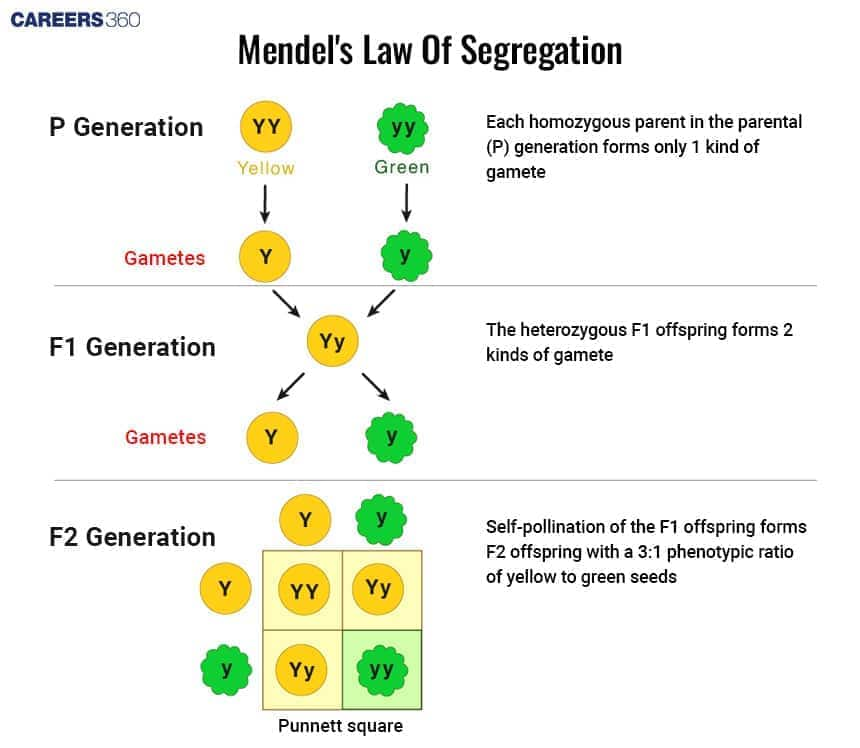Law Of Inheritance: Mendel's Contribution: Dominance, Segregation, Independent
The Law of Inheritance explains how genetic traits are passed from parents to offspring. These principles help scientists to understand why humans inherit certain traits. Gregor Mendel, the father of genetics, performed experiments on pea plants. His observations led to the discovery of the repeated patterns in how traits are passed from one generation to another. These patterns of Mendelian genetics laid the foundation for modern-day genetics.
This Story also Contains
- What is the Law of Inheritance?
- Mendel and His Work
- Mendel's Contribution To The Inheritance Law
- Key Concepts in Mendelian Genetics
- Applications of Mendelian Genetics
- The Recommended Video On Law Of Inheritance: Mendel's Contribution
- MCQs on Mendelian Genetics

Mendel's law of inheritance includes key concepts such as dominance and segregation. The principles of inheritance and variation are not only helpful in biology but also in fields of medicine, agriculture, and behavioral genetics. It continues to guide modern genetic research and gives a foundation in molecular genetics and evolution.
What is the Law of Inheritance?
The Law of Inheritance refers to the fundamental principles that explains how genetic traits are passed from one generation to the next. These laws were given by Gregor Mendel. He conducted experiments on pea plants. Through his work, Mendel discovered that traits are controlled by genes. Each organism inherits two alleles for every trait, one from each parent.
Mendel’s observations led to three key laws: the Law of Dominance, the Law of Segregation, and the Law of Independent Assortment. Together ,these laws explain patterns of inheritance and they are crucial for understanding genetic variations, predicting inheritance patterns using tools like Punnett squares, and studying human genetic disorders.
Mendel and His Work
Gregor Mendel was an Austrian monk, born in 1822. His work in the mid-19th century laid the foundation for genetics. He studied pea plants in the monastery gardens and observed how their traits were passed from one generation to another. His experiments and brilliant observations helped him discover the basic laws of inheritance, now known as Mendel's Laws on Inheritance.

Mendel's Contribution To The Inheritance Law
The experiments Gregor Mendel performed on pea plants performed in the nineteenth century made a breakthrough in terms of genetic inheritance. These experiments revealed key principles that control how characteristics have been passed from parents down to offspring.
Law of Dominance
The first law, also known as Mendel’s Law of Dominance. It states that when two alleles are present in an organism, one allele will mask the effect of the other. The allele that is expressed in the phenotype is called dominant, while the one that is not expressed is called recessive.
In Mendel’s pea plant experiments, the allele for tall plants (T) is dominant over the allele for dwarf plants (t). So, the genotypes TT and Tt result in tall plants, showing the dominant allele masks the recessive one.
Law of Segregation
The first law, also known as Mendel’s Law of Segregation. It explains how the two alleles segregate in gamete formation. Each parent contributes one allele for each gene to the offspring. When fertilization occurs, these alleles combine to form the genetic makeup of the offspring.
Mendel demonstrated this law using monohybrid cross, where he studied the inheritance of a single trait. This principle also explains why offspring inherit traits from parents in predictable ways. Punnett squares are often used to show how these alleles will combine in the next generation.
Law of Independent Assortment
The second law, also known as Mendel’s Law of Independent Assortment. It states that genes for different traits are inherited independently of each other. In simple terms, inheriting one trait does not affect the inheritance of another trait. This helps to increase the genetic diversity in offspring.
Mendel demonstrated the law for the inheritance using dihybrid crosses. He worked on two traits like seed color and seed shape, where there was simultaneous inheritance of the two characteristics.

Monohybrid Inheritance
Monohybrid inheritance refers to how a single trait is passed from one generation to the next. The trait is controlled by one gene with two alleles, from each parent. Mendel studied monohybrid inheritance in pea plants for height of plant (tall vs. dwarf) and pea colour (yellow vs. green).
Through these experiments, he discovered the predictable pattern of inheritance for dominant and recessive traits. For example, tall plants were dominant over the dwarf plants. His work helped to explain how certain traits are present in offspring and how genetic variations are passed within generations. These findings formed the basis of modern genetics.
Dihybrid Inheritance
Dihybrid inheritance is a type of inheritance where two different traits are inherited simultaneously. These traits are controlled by two different genes present on different chromosomes. Mendel's dihybrid crosses involved seed colour and seed shape (yellow vs. green; round vs. wrinkled).
The results of the experiments proved the independent assortment of allele for each trait, establishing the Law of Independent Assortment. This explains how genes for different traits are inherited independently from each other. These findings showed that genetic inheritance can be more complex when multiple traits are involved.
Key Concepts in Mendelian Genetics
The experiments conducted by Gregor Mendel using pea plants allowed him not only to discover the fundamental laws of inheritance but also to lay the foundation for modern genetics.
Genotype Vs. Phenotype
Genotype refers to the genetic makeup of an organism, the combination of alleles it carries for a particular trait. Phenotype is the set of observable traits or physical traits of an organism, which is determined by both its genotype and environment.
Mendel's experiments showed how different genotypes produce specific phenotypes. By studying different traits in pea plants, he demonstrated how the inherited genes control physical features like seed color, seed shape, or flower position. In some cases, gene interaction also plays a role, where multiple genes influence a single trait.
Dominant and Recessive Traits
Through his work on pea plants, Mendel proposed the theory of dominant and recessive genes. For each gene, an organism has two alleles (one from each parent). One will be a dominant allele, meaning it will appear even if one copy is present. The other is a recessive allele; it is only expressed if both copies of the allele are present.
Due to the Law of Independent Assortment, genes may not appear for a generation and then reappear in another generation, depending on which allele is contributed by the parents.
Applications of Mendelian Genetics
Mendelian genetics not only helps to explain how traits are inherited but also has crucial practical functions that helps in identifying and controlling human genetic disorders.
Pedigree Analysis
Pedigree analysis is performed to study the inheritance pattern of specific genetic traits across generations within a family. By making pedigrees that show relationships and the presence of traits, geneticists can track how a disorder is inherited. This helps to identify carriers, predict the chances of disorders, and ultimately diagnose it as early as possible.
The Recommended Video On Law Of Inheritance: Mendel's Contribution
MCQs on Mendelian Genetics
Q1. According to Mendel, ............... segregate and ................. assort independently.
Alleles of a gene; alleles of different genes
Alleles of different genes; alleles of a gene
Dominant traits; recessive traits
Recessive traits; recessive traits
Correct Answer: 1) Alleles of a gene; alleles of different genes
Explanation:
As per Mendel’s law of segregation, parents contain two alleles during the gamete formation, alleles of a pair segregate from each other and gametes receive only one of the two alleles of a gene. As per the law of independent assortment, the inheritance of one pair of alleles of a gene is independent of the inheritance of another pair of another gene.
Hence, the correct answer is option 1 - alleles of a gene; alleles of different genes.
Q2. Select the correct statement for an independent assortment of chromosomes:
Given by Mendel
When two pairs of traits are combined in a hybrid, the segregation of one pair of characters is independent of the other pair of characters.
During anaphase 1 of meioses 1, the two chromosome pairs can align at the metaphase plate independently of each other.
All of these
Correct Answer: 4) All of these
Explanation:
According to Mendel's Law of Independent Assortment, when two pairs of traits are combined in a hybrid the segregation of one pair is independent of the other. This indicates that the chromosomal pairs align at the metaphase plate at random during anaphase I of meiosis, permitting autonomous assortment. Because the inheritance of one allele does not impact the inheritance of another, this method guarantees genetic variety. These principles were all proposed by Mendel.
Hence, the correct answer is option 4)All of these.
Also Read:
Frequently Asked Questions (FAQs)
Pleiotropy is when a single gene affects more than one unrelated trait in an organism.
The law of inheritance explains how traits are passed from parents to offsprings through genes.
The three Mendel’s Law of inheritance are:
Law of Dominance
Law of Segregation
Law of Independent Assortment
The law of dominance states that when two different alleles of a gene are present, the dominant one is expressed in the phenotype of the offspring.
The law of segregation states that two alleles separate during the formation of a gamete and carry only one allele for each gene.